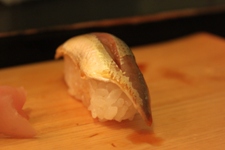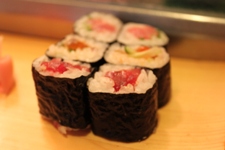Common sushi variations
- Published 2010.7.13
Common sushi variations
In Japan, the most common type of sushi is nigirizushi but there are other various types nationwide.

Nigirizushi (µÅĪŃéŖÕ»┐ÕÅĖ/Lit. Moulded sushi)
This type of sushi is made by placing raw sliced fish (Õł║Ķ║½/sashimi) or fried egg (ÕŹĄńä╝) etc, on top of hand-moulded vinegared rice. In Japan it is also common to put a small amount of wasabi in between the rice and fish. Sushi without wasabi is called sabinuki (ŃüĢŃü│µŖ£ŃüŹ). The act of moulding rice is where sushi chefs demonstrate their skill. Conveyor-belt sushi restaurants (Õø×Ķ╗óŃüÖŃüŚ) have recently increased in numbers, and now you can even find restaurants which have robots making the sushi.

Makizushi (ÕĘ╗ŃüŹÕ»┐ÕÅĖ/Lit. Wrapped sushi)
Makizushi refers to rolled sushi, where dried gourd, cucumber, natt┼Ź, salmon etc. is covered in vinegared rice and wrapped in seaweed. Also called norimaki (µĄĘĶŗöÕĘ╗ŃüŹ), this type of sushi is divided by thickness, with thin, medium, and thick available.
Inarizushi (ŃüäŃü¬ŃéŖÕ»┐ÕÅĖ)
Derived from the belief that foxes, which are strongly connected to the god of harvests, Inari, have a fondness for fried tofu, inarizushi consists of vinegar rice mixed with mushrooms and dried gourd stuffed into a pouch of this fried tofu. This type of sushi started being sold at the end of the 18th Century. Now there are basically two types, one being with only vinegar rice stuffed into the tofu, and the other with carrots, shiitake mushrooms and sesame seeds mixed in with the rice.
Chirashizushi (ŃüĪŃéēŃüŚÕ»┐ÕÅĖ/Lit. Scattered sushi)
There are two distinct variations of chirashizushi, one with garnish placed on top and one with the garnish mixed in. Also varying by region, most times a soup accompanies the meal, such as miso shiru (Õæ│ÕÖīµ▒ü). This type of sushi is commonly made in Japanese households.
